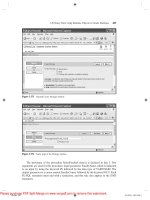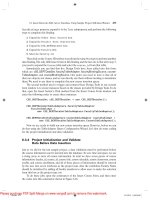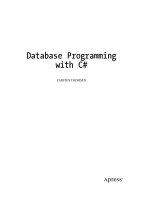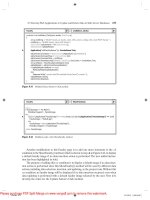C++ Programming with CORBA pptx
Bạn đang xem bản rút gọn của tài liệu. Xem và tải ngay bản đầy đủ của tài liệu tại đây (1.4 MB, 344 trang )
Page i
C++ Programming with CORBA
®
Andreas Vogel
Bhaskar Vasudevan
Maira Benjamin
Ted Villalba
Page ii
Publisher: Robert Ipsen
Editor: Robert Elliott
Assistant Editor: Pam Sobotka
Managing Editor: Angela Murphy
Electronic Products, Associate Editor: Mike Sosa
Text Design & Composition: North Market Street Graphics
Designations used by companies to distinguish their products are often claimed as trademarks.
In all instances where John Wiley & Sons, Inc., is aware of a claim, the product names appear
in initial capital or ALL CAPITAL LETTERS. Readers, however, should contact the
appropriate companies for more complete information regarding trademarks and registration.
This book is printed on acid-free paper.
Copyright © 1999 by Andreas Vogel, Bhaskar Vasudevan, Maira Benjamin, Ted Villalba • All
rights reserved.
Published by John Wiley & Sons, Inc.
Published simultaneously in Canada.
No part of this publication may be reproduced, stored in a retrieval system or transmitted in
any form or by any means, electronic, mechanical, photocopying, recording, scanning or
otherwise, except as permitted under Sections 107 or 108 of the 1976 United States Copyright
Act, without either the prior written permission of the Publisher, or authorization through
payment of the appropriate per-copy fee to the Copyright Clearance Center, 222 Rosewood
Drive, Danvers, MA 01923, (978) 750-8400, fax (978) 750-4744. Requests to the Publisher
for permission should be addressed to the Permissions Department, John Wiley & Sons, Inc.,
605 Third Avenue, New York, NY 10158-0012, (212) 850-6011, fax (212) 850-6008, E-Mail:
PERMREQ @ WILEY.COM.
This publication is designed to provide accurate and authoritative information in regard to the
subject matter covered. It is sold with the understanding that the publisher is not engaged in
professional services. If professional advice or other expert assistance is required, the
services of a competent professional person should be sought.
Library of Congress Cataloging-in-Publication Data:
ISBN 0-471-28306-1
Printed in the United States of America.
10 9 8 7 6 5 4 3 2 1break
Page iii
Contents
Chapter 1
Introduction
1
1 Benefits of C++ Programming with CORBA
1
1.1 What Does CORBA Offer C++ Programmers?
2
1.2 What Does C++ Offer CORBA Programmers?
5
2 C++ Overview
6
2 C++ Overview
6
2.1 Objects and Classes
7
2.2 Encapsulation
7
2.3 Modularity and Scoping
8
2.4 Inheritance
8
2.5 Method Overloading
8
2.6 Exceptions
9
2.7 Hello World Example
9
3 Overview of C++ ORBs
11
3.1 Terminology
11
3.2 Clients and Servers as C++ Applications
12
3.3 Clients and Servers Implemented with Non-C++ ORBs
15
4 Building a First C++ ORB Application
17
4.1 Summary of the CORBA Development Process
18
4.2 Environment Setup
19
4.3 Interface Specification
19
4.4 Compiling the IDL
20
4.5 A Client as a C++ Application
21
4.6 Object Implementation
23
4.7 A Server as a C++ Application
24
4.8 Compiling the Server and the Client
26
4.9 Running the Application
27
Chapter 2
CORBA Overview
29
1 The Object Management Group
30
1 The Object Management Group
30
1.1 OMG's Goals
30
Page iv
1.2 The Organizational Structure of the OMG
30
1.3 OMG Technology Adoption Process
34
2 The Object Management Architecture
35
2.1 Overview of the OMA
36
2.2 Core Object Model
36
2.3 The Reference Model
41
3 Common Object Request Broker Architecture
44
3.1 Overview
44
3.2 Object Model
46
3.3 ORB Structure
49
3.4 OMG Interface Definition Language (IDL)
52
3.5 ORB and Object Interfaces
63
3.6 Basic Object Adapter
71
3.7 The Portable Object Adapter
75
3.8 Language Mappings
84
3.9 Interoperability
85
3.10 TypeCode, Any, and DynAny
87
3.11 Dynamic Invocation and Dynamic Skeleton Interfaces
92
3.12 Interface Repository
94
3.12 Interface Repository
94
Chapter 3
OMG IDL to C++ Mapping
107
1 Mapping Modules
107
2 Mapping Basic DataTypes
108
3 Mapping Strings
109
4 Mapping Constants
111
5 Mapping Enumerations
112
6 Mapping for Structured Types
112
6.1 Mapping for Struct Types
114
6.2 Mapping Union Types
116
6.3 Mapping Sequence Types
118
6.4 Mapping for Arrays
121
6.5 Mapping Typedefs
123
6.6 Mapping the Type Any
124
7 Mapping for the Exception Types
130
8 Mapping Operations and Attributes
131
9 Argument Passing
133
9.1 Examples
136
10 Mapping of Interfaces
163
10.1 Client-Side Mapping
163
10.2 Server-Side Mapping
163
Page v
Chapter 4
ORB Runtime System
167
1 Object Interface
168
1.1 get_implementation()
168
1.2 get_interface()
168
1.3 is_nil()
169
1.4 duplicate() and release()
169
1.5 is_a()
169
1.6 non_existent()
169
1.7 is_equivalent()
170
1.8 hash()
170
1.9 create_request()
170
2 ORB Interface
171
2.1 ORB Initialization
171
2.2 Converting Object References into Strings and Vice Versa
171
2.3 Obtaining Initial References
172
2.4 BOA Initialization
173
2.5 POA Initialization
173
3 Basic Object Adapter
173
3.1 Activation and Deactivation
173
3.2 Other Operations
174
4 TypeCodes
175
4.1 Interface TypeCode
175
4.2 Creating TypeCodes
179
4.2 Creating TypeCodes
179
5 Dynamic Invocation Interface
182
5.1 Common Data Structures
182
5.2 Creating an NVList
183
5.3 NVList Interface
183
5.4 DII Request
184
5.5 Creating a Request
184
5.6 Request Interface
185
6 Dynamic Skeleton Interface
187
6.1 ServerRequest Interface
188
7 Context Interface
188
7.1 Creating a Context Object
189
7.2 Manipulating a Context Object
189
7.3 Manipulating the Context Object Tree
190
8 Portable Object Adapter
191
8.1 POA Policies
191
8.2 POAManager Interface
195
8.3 AdapterActivator Interface
197
8.4 ServantActivator Interface
198
8.5 ServantLocator Interface
199
8.6 POA Interface
201
8.7 Current Operations
207
Page vi
Chapter 5
Discovering Services
209
1 Bootstrapping
209
2 The CORBA Naming Service
210
2.1 Overview of the Naming Service
210
2.2 Interface Specification
211
2.3 Using the Naming Service from a C++ Client
218
3 Trading Service
221
3.1 Overview of Trading
222
3.2 Overview of the Trading Service Interfaces
226
3.3 Exporting a Service Offer
238
4 Domains
257
5 Proprietary Object Location
258
Chapter 6
Building Applications
261
1 Application Specification
261
1.1 IDL Specification
263
2 Implementing Objects
264
2.1 Implementing the Meeting Object
264
2.2 Implementing the Room Object
265
3 Building Servers
268
3.1 Initializing the ORB
270
3.2 Creating an Object, Registering with the Root POA
270
3.3 Registering with the Naming Service
271
3.3 Registering with the Naming Service
271
3.4 Entering the ORB's Event Loop
272
4 Building Factories
272
4.1 Meeting Factory Object Implementation
273
4.2 Meeting Factory Server
274
5 Starting Servers
276
6 Building Clients
277
6.1 Client Application
278
6.2 Methods in the Client Application
279
7 Extensions to the Example Application
287
Chapter 7
Advanced Features
289
1 The Extended Hello World Example
289
1.1 Interface Specification
289
Page vii
1.2 A Client
290
1.3 Servant Implementation
292
2 The Any Type and TypeCodes
294
2.1 Interface Specification
294
2.2 Object Implementation
295
2.3 Client Implementation
297
3 Interface Repository and Dynamic Invocation Interface
301
3.1 Initializin
g the ORB
302
3.1 Initializin
g the ORB
302
3.2 Browsing the Interface Repository
304
3.3 A Simple Unparser
305
3.4 Initializing Requests
307
3.5 Creating Supporting Objects
307
3.6 Using the Supporting Objects
309
3.7 Creating and Invoking a Request Object
310
3.8 Getting Results
310
3.9 Executing the Client
312
4 Dynamic Skeleton Interface
314
5 Tie Mechanism
317
6 IDL Context
321
6.1 Creating a Context
321
6.2 Invoking the Method
322
6.3 Getting Values from the Context
322
Glossary 325
Index 331
Page ix
Foreword
While it may seem somewhat retrograde in 1999 to publish a book which centers on C++
(rather than the hot C-based language, Java), this book will find an important place in the
library of programmers everywhere. Even as Java turns 35 in dog years (oops, I guess I mean
Internet years!), or about five in human reckoning, according to most surveyors of the
programming scene C++ is still the primary C-based language, especially in mission-critical,
high-performance systems. Fortunately, the CORBA technology discussed in this tome (as was
discussed in its predecessor Java-based version) excels at solving cross-language integration
problems. In fact, the de facto standard CORBA architecture provides interoperability in
thousands of distributed, heterogeneous enterprise-wide applications worldwide today;
heterogeneous not just in programming language but in operating system, underlying network
connection, and hardware platforms as well. This C++ revision of the book provides another
strong platform for understanding and implementing CORBA technology with confidence.break
RICHARD MARK SOLEY, PH.D.
CHAIRMAN AND CEO,
OBJECT MANAGEMENT GROUP, INC.
Page xi
Acknowledgments
First of all, we want to thank those people who assisted us in writing this book. These are our
editors at John Wiley and Sons, Robert Elliott, Pam Sobotka, Angela Murphy, and the Wiley
production team.
Thanks to Keith Duddy, who wrote many CORBA-related sections of Java Programming for
CORBA which have been the base of this book and to Michael McCaffrey, who helped with
some of the POA examples.
Special thanks to Inprise's Visibroker team, specifically to Prasad Mokkapati, Jon Goldberg,
Tom Casaletto, Vijay Natarajan, Nick Trown and Vishy Kasar, which made an early
Visibroker release, which supported the POA, available to us and gave support and guidance
for using the POA features. We also thank Peter Holzwarth for his help with the Visibroker
Trader implementation.
We acknowledge the corporation of the OMG, and in particular Richard Soley.
Thanks to Meta and Dorit for letting me work on evenings and weekends instead of going out or
to the beach. I promise the next book will be the last one, for a while.
Also a word of thanks to Mike Cook of Bellcore who I helped designing and building a cool
CORBA-controlled, Java-implemented IP telephony system. Mike always teased me that my
CORBA books don't have any comics featuring out-of-space characters. Well, Mike, this one
doesn't have any comics either, but I recommend as a supplement publications by Hank Hill
which are of great educational value specifically when you raise an American boy as you do.
—ANDREAS
I am extremely grateful to Prasad Mokkapati, Jon Goldberg, Ke Jin, Nick Trown, and Vijay
Natarajan, to whom I owe all I have learnt about the ORB so far. I am grateful to my family and
friends to whom I owe all I am today.
—BHASKAR
To Jazzy and Scott for giving me the love, support, and understanding that I needed to get this
book done and to all of my friends and family thatcontinue
Page xii
believed in me—you know who you are! I truly believe that without the support of the people
that you care for, you cannot achieve any of the goals that you are passionate about.
—MAIRA
I would also like to thank my mother for her amazing patience and unconditional love, thank my
father for his guidance and dedicate my efforts to my sister Elena for teaching me that recycling
is a way of life: paper, plastic, aluminum, code . . .continue
—TED
Page xiii
About the Authors
Andreas Vogel is a Principal Consultant with Inprise Corporation since January 1997. In this
position he works with customers, mostly Fortune 500 companies, on CORBA solutions for
their distributed computing needs. More recently, he is also involved in strategy and product
development.
Prior to this appointment, Andreas worked at the Distributed Systems Technology Centre
(DSTC) in Brisbane, Australia in the position of a Principal Research Scientist, working on
various aspects of distributed systems including CORBA2.0 Interoperability, OMG's Object
Trader specification, CORBA-DCE interoperability, Web and middleware integration, and
distributed multimedia systems. From 1993 to 1994, he worked as a Research Scientist for the
University of Montreal, Canada, on quality of service issues of multimedia applications.
Andreas has co-authored Java Programming with CORBA (John Wiley & Sons, 1998), and is
now working on a new book on Enterprise JavaBeans, the Java Transaction Service, and the
CORBA Object Transaction Service. Andreas is Java Report Online's CORBA columnist and
is a contributor to the Middleware Spectra. He also serves on program committees and
advisory boards of a number of international conferences, workshops, and journals devoted to
different aspects of distributing computing. Andreas holds a PhD and MSc in Computer
Science from Humboldt-University at Berlin, Germany.
Andreas lives with his wife Dorit G. Hillmann and daughter Meta J.D. Hillmann in San
Francisco. When not being at customer sites, he enjoys the 35 km commute to the San Mateo
office on his bicycle.
Bhaskar Vasudevan, a Software Engineer with Inprise Corporation, is part of the VisiBroker
for C++ team. Prior to this, he was a Member of Technical Staff with the Networking Products
Development group at Oracle Corporation. He earned his Masters degree in Computer Science
from the Rensselaer Polytechnic Institute, New York. He is interested in distributed computing
and object-oriented programming. He currently lives in San Mateo, California.break
Page xiv
Maira Benjamin, a Senior Support Engineer with CrossWorlds Software, has extensive
expertise in educating and supporting customers and consultants to use complex business
solutions. She uses her knowledge of originating technologies such as CORBA, Java, C++,
Message Queuing, RDBMs, and data mapping tools to support interchange of data between the
companies' solutions and other business solutions such as PeopleSoft and SAP.
Maira enjoys a successful career in high tech that included time at well-known companies
including ASK, Sybase, UNIFACE, and Visigenic Software. She's held various engineering
posts from porting and development to manager of maintenance, QA, and code management.
Maira has also lent her talents to the consulting arena.
Maira enjoys the company of her husband Scott and her daughter Jasmine in their home located
in the San Francisco Bay Area. Maira would like more opportunities to practice her Spanish,
French, Japanese, and Sign Language. Some of her other passions are dancing, fashion, and
going out with her friends.
Ted Villalba lives in San Francisco, works at Broadvision in Redwood City, and spends as
much time as possible on a mountain bike in the mountains between the two.break
Page xv
How to Read This Book
This book introduces C++ Object Request Brokers (ORBs) to an audience familiar with the
basic concepts of object-oriented programming and distributed systems. It contains chapters
that fall into three categories: introduction and background, tutorial, and reference.
Chapter 1 gives motivation for the use of C++ ORBs, as well as an introduction on CORBA
programming in C++. Chapter 2 is a solid introduction to CORBA. Chapters 3 and 4 explain
the complete mapping from IDL to C++ and the C++ mapping of all CORBA interfaces. The
new Portable Object Adapter is explained and many examples, specifically for the nontrivial
memory management in C++, are given.
Chapter 5 introduces two fundamental CORBA Services, the Naming and the Trading Service,
and demonstrates their use. This chapter also covers the bootstrap mechanisms for CORBA
applications. Chapter 6 shows how to build applications with C++ ORBs using a room
booking example. Advanced features are explained in Chapter 7. They include the Any type
and TypeCodes, the Dynamic Invocation Interface and the Dynamic Skeleton Interface, the Tie
mechanism, and Contexts.
Besides the default approach of reading the book front to back, we suggest the following paths
through the book. Beginners should start with Chapter 1 and then continue with Chapters 5 and
6 and eventually 7. Chapters 2, 3 and 4 can be used as references as needed.
Advanced programmers will have experience with C++ and CORBA and may be most
interested in the POA features and examples that are distributed throughout the book.
We recommend the book for self-teaching as well as source material for training and university
courses. In any case, it is recommended that users work through the examples provided. The
source code can be obtained from the John Wiley & Sons web site at />compbooks/vogel. The web site is organized according to chapters, and should be easy to
navigate.break
Page xvi
Please note that the sample code in the book was tested against a beta of VisiBroker 4.0, but
should work with any ORB that includes the Portable Object Adapter (POA). Please check our
companion web site for updates reflecting new ORB releases.
Page 1
Chapter 1—
Introduction
1—
Benefits of C++ Programming with CORBA
This book brings together C++, the most widely used object-oriented programming language,
and the Common Object Request Broker Architecture (CORBA), the most popular
object-based distributed middleware. CORBA, a standard produced by the Object
Management Group (OMG)—the world's largest industry consortium—defines an
infrastructure that enables invocations of operations on objects located anywhere on a network
as if they were local to the application using them. Although CORBA is defined to support
many programming languages, C++ is the most popular language for implementing CORBA
objects.
The OMG Interface Definition Language (IDL) is a language which allows you to specify the
interface of objects in an implementation and programming language independent manner.
Conceptually and syntactically, the OMG IDL uses many C++ language conventions, so the
mapping from IDL to C++ is a very natural progression.
Throughout this chapter, we look at the advantages of using CORBA for C++ users and the
advantages of using C++ for programming distributed systems with CORBA. Similarly, we
provide some explanation of the object-hard
Page 2
oriented concepts of C++ in the context of CORBA. We will also give an introduction to
CORBA and C++ Object Request Brokers (ORBs). Finally, we explain how to program with
C++ ORBs by introducing a simple example.
1.1—
What Does CORBA Offer C++ Programmers?
The major advantages of using CORBA to build distributed applications with C++ are
• Interoperability across programming languages and operating systems
• Open standardization of CORBA
• Vendor independence
• Legacy integration
• Location transparency
• Programmer productivity
• Reusing CORBA services and facilities
1.1.1—
Interoperability across Programming Languages and Operating Systems
CORBA defines an architecture for building distributed systems (for details see Chapter 2).
One of the core pieces of CORBA is the OMG IDL, a language used to define interfaces to
potentially distributed objects. IDL is program language independent and there are a growing
number of specifications that define the mapping from IDL into programming languages.
Currently there are mappings defined for the following languages: C++, Java, C, Smalltalk,
Ada, and COBOL. Products implementing the CORBA architecture provide IDL compilers that
generate code into a programming language for your IDL specification.
The benefit of IDL is that you can choose the most appropriate programming language for a
certain task. This allows you to choose Java to implement applets, and thus provides access to
applications from within a web browser. On the other hand, you can choose to use C++ to
implement your objects on the server side.
Similarly you can have multiple clients to an application using different presentation models.
This means that you can have an applet as well as a spreadsheet as a front end in the same
application.
1.1.2—
Open Standardization of CORBA
The OMG is defining the standard for CORBA, which in turn is implemented by companies,
also known as ORB vendors. Since the OMG is a vendor consortium that is open to everyone,
you can participate in the processcontinue
Page 3
of what is defined by the OMG. A specification adopted by the OMG must be implemented by
the submitters.
1.1.3—
Vendor Independence
Since CORBA is an open standard, anyone can implement it without having to obtain a license
from the OMG or anyone else. Hence there are lot of vendors providing CORBA
implementations. However, there are only a handful of companies providing full-featured,
industrial-strength CORBA implementations, including support for multiple programming
languages and a rich set of CORBA services and facilities. In addition, there are many
companies that have CORBA-enabled their products. Examples of such products are Web
servers, databases, operating systems, and networks. Finally, there are a number of research
institutions that provide free CORBA implementations, often including the source code.
You can choose an appropriate ORB vendor depending on your requirements. You can write
code so that it can be easily ported to a different ORB product, just in case you decide to
switch products or your ORB vendor goes out of business. To achieve this portability, you
must restrict yourself to the application programming interfaces (APIs) defined by the CORBA
specifications. However, ORB vendors often provide a value-added feature set that makes the
programming easier. Essentially it's a trade-off.
Besides the portability, you must also consider the interoperability of different components or
subsystems that are implemented with different ORB products. CORBA specifies a hierarchy
of interoperability protocols: the General Inter-ORB Protocol (GIOP), which is transport
independent, and the Internet Inter-ORB Protocol (IIOP), which is the TCP/IP implementation
of GIOP. These protocols are a mandatory part of the CORBA specification (since version
2.0). Details are given in Chapter 2. The protocols ensure interoperability between components
implemented with different products. You can see a live demonstration of CORBA
interoperability at the CORBAnet website (www.corba.net).
1.1.4—
Legacy Integration
There are two reasons to use CORBA. One is to build new distributed applications with an
object-based architecture. The other is to integrate existing systems into new applications. The
way CORBA integrates legacy system implementations is to wrap those systems into a layer of
IDL interfaces. You only need to write a layer of code which, in turn, makes the wrapper IDL
interface call functions on the legacy APIs. That can be rather straightforward for libraries
written in C, C++, or COBOL for which there are existing IDL mapping standards. If you have
code in other legacy languages, forcontinue
Page 4
example, in FORTRAN or PL/1, you can wrap it using a C or C++ layer between the CORBA
interfaces and the legacy code. The glue layer becomes more complex when the legacy system
does not support the notion of a functional API. For example, a CICS interface to a mainframe
application could require parsing screens to extract data. However, once the legacy system has
been wrapped with a layer of IDL interfaces, it becomes very easy to enhance it with
additional functionality, to integrate it with another application, or to expose its functionality in
a web browser.
1.1.5—
Location Transparency
If you build distributed systems with simpler mechanisms than CORBA, such as remote
procedure calls (RPCs) or transport protocol APIs such as sockets, you typically need to know
exactly where a server is located. For example, when using TCP/IP networking, a client needs
the IP address and port number of a server.
CORBA provides the notion of an object reference, a concept known from C++ and other
object-oriented programming languages. But while a C++ object reference is only valid in the
address space of a program, a CORBA object reference is valid across processes, machines,
programming languages, and ORB products. CORBA object references are often abbreviated
as interoperable object references (IORs). Once a component has obtained an IOR it creates a
client proxy which encapsulates all of the complexity of networking, and a developer only
needs to write code against the signature of this local object, in our case C++.
CORBA goes even further. IORs and client proxy objects are still valid in the case that the
object implementation changes its location. The ORB's communication infrastructure forwards
your invocations to the relocated object.
1.1.6—
Programmer Productivity
The CORBA environment maximizes programmer productivity. As you have just seen, CORBA
frees a developer from most of the complexity of network programming. There is no need to
deal with address information, network connections, or writing code for marshaling and
unmarshaling your application data structure in byte streams. CORBA gives you the freedom to
choose the programming language that is most appropriate for your task and that best fits the
skill set of your developers.
CORBA is not the only core component that can handle your invocations on potentially remote
objects. There is an increasing number of services and horizontal and vertical facilities that are
specified by the OMG and implemented by ORB and component vendors. There are a good
number of such services available today. In the next section we provide more details.break
Page 5
The encapsulation of code in objects enables reusability. This is a benefit you probably won't
see when you implement your first CORBA application. But with a second application, you
will find that certain business objects you built in the first application are reusable in the
second one.
1.1.7—
Reusing CORBA Services and Facilities
As mentioned earlier, the OMG has specified a growing set of services and facilities for
common horizontal and vertical tasks. Following is a list of the most common and widely used
services:
Naming Service. White pages for CORBA objects (see Chapter 5).
Object Trading Service. Yellow pages for CORBA objects (see Chapter 5).
Event Service. An asynchronous, subscription-based messaging service.
Security Service. Securing CORBA applications.
Object Transaction Service. Transaction processing for distributed objects.
There are a number of Domain Task Forces (DTFs) within the OMG which actively work on
vertical services and facilities. In particular, the Telecom DTF and the CORBAmed DTF have
produced a number of services and facilities. For details and activities of other DTFs, see
Chapter 2 and the OMG web site for the latest updates.
1.2—
What Does C++ Offer CORBA Programmers?
The main reason for using a C++ language mapping of the OMG IDL is to take advantage of the
following C++ features:
• Performance that is closely tied to the machine
• Ties to legacy systems/architectures
• Low-level programming
1.2.1—
System Performance
C++ was designed with a strong focus on the performance of executables. C++ compilers
provide various levels of sophistication for optimizing executable code. The target of a C++
compiler is typically the native instruction set of a specific platform. The design of other
object-oriented languages such as Java and Smalltalk has followed other priorities, mostly
productivity and portability. The compilers for these two languages produce
platformindependent, intermediate code, which is then executed by an interpreter.continue
Page 6
Although many attempts are ongoing to improve the performance of code, particularly that
written in Java, executables generated by highly optimized C++ compilers are still more
efficient.
1.2.2—
Legacy Systems/Architectures
Today we face quite a bit of legacy code, which if it had to be rewritten would be quite
expensive. However, as explained, CORBA provides an excellent way of making this code
available through object wrapping. The C++ language mapping is a key CORBA feature that
makes this happen. The wrapping of C and C++ code is straightforward. For almost any
programming language, there exists an API into the C/C++ world that allows access to
libraries written via CORBA through the C++ mapping.
You might ask, why not use the IDL/C mapping instead of C++? Although this works, the IDL/C
mapping is not as natural as the C++ one, since C does not have all of the object-oriented
features, making the mapping somewhat awkward. The call of C APIs from a C++ class,
however, is straightforward.
1.2.3—
Low-Level Programming
C++ has, through its C inheritance, the capability to write low-level code. This is hard or
impossible to do with languages such as Java or Smalltalk. Combined with the natural IDL
mapping, this makes C++ the language of choice for implementing CORBA interfaces to
low-level tasks, for example, controlling interfaces for device drivers.
2—
C++ Overview
C++ supports object-oriented programming. This section discusses object-oriented principles
within C++ that have significance to CORBA. There may be occasional references to CORBA.
Please note that this is not meant to serve as a tutorial. For detailed discussions and
observations concerning the language, please refer to one of the many books on C++.
The central proposition of object-oriented design is the definition of objects and the operations
that are invoked by them. Object-oriented design uses the following ideas:
• Encapsulation
• Modularity
• Abstraction/Interfaces
• Inheritance
• Exceptions/Overloadingbreak
Page 7
Throughout this section we use C++ coding samples to help explain the concepts. We will end
the section with a Hello World example. Although it is simple, it does help to illustrate some
of the concepts presented. Later in this chapter we will distribute this example using CORBA.
2.1—
Objects and Classes
There is a differentiation between objects and classes within the object-oriented design
concept. A class is a type and an object is an instance of a class. That means a class is a static
entity described in your code and an object is a runtime representation of this code. There can
be many objects/instances of the same class/type. For example, you can declare a class bridge
which is a type describing the concept of a bridge in generic terms. We can have bridge objects
that are instances of the class bridge, for example, the Bay Bridge, the Tri-Borough Bridge, the
London Bridge, etc.
Classes in C++ can be virtual or concrete. A virtual class defines only the signature. A
signature is the syntax of the type. This is also known as an interface in generic
object-oriented terms. Java and OMG IDL rely heavily on the concept of an interface. In our
bridge example, a virtual class defines the signature of a bridge with members such as int
yearCompleted, int length, and methods like payToll().
A virtual class must be fully implemented to make a program that contains objects of this class
executable. The concrete class is also known as the implementation. It completely defines the
behavior of the class. A C++ convention is to define a class virtually in a header file and
provide the implementation of the methods in an implementation file.
OMG IDL is only concerned with the definition of interfaces that are mapped to virtual classes.
It is the application programmer's responsibility to provide implementations of the methods of
the virtual classes.
2.2—
Encapsulation
Encapsulation builds on the concept of abstraction (or hiding) of implementation details. The
idea is to show and provide access to a number of member variables and methods to an outside
entity. Variables and methods can be declared private or public. The concept of
friend weakens the clarity of this concept for pragmatic reasons. Generally only member
variables and methods declared as public can be accessed or invoked from the outside of
the object.
OMG IDL is only concerned with the definition of the publicly available attributes and
operations. Attributes and operations are mapped to public C++ methods.break
Page 8
2.3—
Modularity and Scoping
Modularity simply means that a program can be separated into various parts. Scoping means
that these parts have separated namespaces. That means you use the same identifiers in various
parts. C++ contains better facilities than C for modular programming. C++ does this through the
mechanism known as namespace. The concept of namespace allows you to group related
data, functions, and the like.
Although C++ defines namespaces to separate namespaces of different components, only
recently have C++ compilers supported this concept. The scope of nested classes can be used
to a certain extent as an alternative scoping mechanism.
OMG IDL uses the concept of module to separate different namespaces. The IDL/C++ mapping
defines two alternatives: a mapping to C++ namespaces where available and to the nested
classes otherwise.
2.4—
Inheritance
C++ supports the concept of inheritance of classes. A class, known as the derived class, can
inherit from another class, known as the superclass. That means that the derived class will have
all of the member variables and methods of the superclass and can define additional ones. For
our bridge example we can define a class TrainBridge which inherits attributes from the
superclass Bridge and adds a member variable int numberOfTracks. Inheritance can
be applied recursively. For example, we can define a class AmericanTrainBridges that
will inherit attributes from the class TrainBridge.
C++ also supports the notion of multiple inheritance. This means that a class can inherit any
number of superclasses. Multiple inheritance of concrete classes has a potential problem.
When a class inherits the methods with the same signature from different superclasses, they can
have different implementations. The behavior of this method in the derived class is undefined.
OMG IDL also supports the inheritance of interface, including multiple inheritance. The
problem described above does not apply because there is no behavior associated with methods
in IDL.
2.5—
Method Overloading
C++ provides method overloading. This means there can be multiple definitions of methods
with the same method in a class as long as the method result type and the parameter types allow
distinguishing between the various methods. This concept also applies to multiple classes that
are in an inheritance relationship.break
Page 9
OMG IDL does not allow the overloading of operations. The motivation is in the mapping of
IDL to programming languages that do not provide the concept of method overloading.
2.6—
Exceptions
Exceptions provide an alternative termination of a method. Exceptions are often used to handle
errors or other exceptional conditions. C++ defines exceptions as classes and hence allows
inheritance of exceptions.
An entity can invoke methods that can raise exceptions. The entity can then decouple the
exception handling from the unexceptional behavior by encapsulating the method invocations
into a try-catch block. When a method raises an exception, it triggers the catch block in the
invoked program.
OMG IDL also defines exceptions. However, exceptions are datatypes similar to structures and
not objects. Hence inheritance does not apply to exceptions in IDL.
2.7—
Hello World Example
We will introduce a simple C++ example, a Hello World program. We show the optional
definition of a C++ virtual class and its implementation. We then explain how to build a C++
application. The object of the implementation class is created and a method is invoked on the
object. We return to the same example later in the chapter where we will distribute the
components.
The Hello World example contains an object of a class GoodDay that provides a method
hello(). This method returns a string containing the message, "Hello World, from location,''
where location is the name of a geographical location, for example, Brisbane.
2.7.1—
Defining the Signature and Implementation Class
A C++ interface defines the signature of an object, its types, fields, and methods. Hence it
allows various substitutable implementations. For our example we define the interface
GoodDay, which has one method, hello(). This is defined in the header file, GoodDay
.h, for this example.break
//GoodDay.h
class GoodDay{
char * hello();
};
Page 10
2.7.2—
Implementing the Class
As we noted before, we need to create an implementation class which we will use to execute
the hello() operation. The hello() operation will return the locality which we set in the
constructor of the object. This implementation of the class we put in the GoodDayImpl.cpp
file.
//GoodDayImpl.cpp
#include "fstream.h"
#include "GoodDay.h"
class GoodDayImpl : public GoodDay{
private:
char* _locality;
public:
GoodDayImpl (char *locality) : _locality(locality){}
char *hello(){
return(_locality);
}
};
2.7.3—
Creating and Invoking the Object
We create a GoodDay object in the main() routine of our program. We initialize with the
location "Brisbane." We then invoke the hello() method on the GoodDay object and print
out the result.
//GoodDayServer.C
#include <GoodDayImpl.cpp>
int main(int argc, char* const* argv){
//Create a GoodDay object.
GoodDayImpl goodDayImpl( "Brisbane" );
//invoke method hello() and print result
cout << "Hello World, from " << goodDayImpl.hello() << endl;
return(0);
}
2.7.4—
Build and Execute
The final step in order for us to execute the Hello World program is to build the executable.
We compile the two C++ files and link them. Now we can run the executable, which prints the
following message:break
Hello World, from Brisbane
Page 11
3—
Overview of C++ ORBs
A C++ ORB is an ORB that supports a C++ language mapping for OMG IDL. This language
mapping, or language binding, allows clients and objects to be implemented in C++. A C++
ORB must offer a complete implementation of the CORBA specification.
This section introduces the architecture of the C++ ORB. First, we examine some necessary
terminology. We then discuss the requirements for C++ applications to communicate with
CORBA objects. Specifically, we cover the following topics:
• C++ ORB features
• C++ applications as clients and servers
• Clients and servers implemented using other programming languages
3.1—
Terminology
In this section and throughout the rest of the book we will use a number of terms that have
specific technical meanings. Because both CORBA and C++ are object-oriented and have
similar object models at the interface level, some terms will apply to both. However, most of
the time we will use different language to refer to concepts in each domain. Here is the way in
which we will differentiate:
Object. Refers to some program component that has a well-defined interface. We
usually refer specifically to CORBA objects, whose interfaces are represented in OMG
IDL, and C++ objects, whose interfaces are represented by C++ variables and method
declarations.
Operation. An action that can be invoked on a CORBA object, as defined in IDL.
Method. An action that can be invoked on a C++ object, as defined in that object's
public class declaration. C++ objects can implement CORBA interfaces. Methods on
these objects correspond to operations in the CORBA interface.
Client. A role that is played by a program in the context of an invocation.
Server. A role that is played by a CORBA object in the context of an invocation. Many
programs that are servers are also clients to other servers.
CORBA Server. An operating system process that is hosting one or multiple objects
and object adapters.break
Page 12
Object Adapter. A component of the ORB which connects CORBA objects with the
ORB runtime system. It can make CORBA objects accessible to clients, activate or
deactivate CORBA objects, control threading policies, etc.
3.2—
Clients and Servers as C++ Applications
Figure 1.1 illustrates the simplest scenario involving C++ ORBs: a client interacting with a
server. Client and server are both implemented in C++. Figure 1.1 is an abstract representation
of the client-server model in C++ ORBs. We see three components in the figure: the client, the
server, and the ORB. The client communicates with the ORB in order to convey a request for
an operation invocation to the server, which then sends results via the ORB back to the client.
The interfaces these components use are defined by the CORBA standard and by the
application-specific IDL definitions that the object at the server supports.
Figure 1.2 shows a more concrete view of how the ORB performs the task of conveying an
invocation from client to server. Most C++ ORBs are implemented as libraries that are linked
into a program. The lightly shaded objects in Figure 1.2 are provided by the ORB (compare
with Figure 2.4). The following sections describe the functionality of each of these
components.
3.2.1—
Stub and Skeleton Code
The IDL compiler generates a number of C++ classes known as stub classes for the client and
skeleton classes for the server. The role of the stub class is to provide proxy objects that
clients can invoke methods on. The proxy object method implementations invoke operations on
the object implementation, which may be located remotely. If the object implementation is at a
remote location, the proxy object marshals and transmits the invocation request. That is, it takes
the operation name and the types and values of its arguments from language-dependent data
structures and places them into a linear representation suitable for transmitting across a
network. The code to marshal programmer-defined datatypes is an essential part of the
stubcontinue
Figure 1.1
Client-server model with C++ ORBs: abstract view.
Page 13
Figure 1.2
Client-server model with C++ ORBs: concrete view.
code. The resulting marshaled form of the request is sent to the object implementation using the
particular ORB's infrastructure. This infrastructure involves a network transport mechanism
and additional mechanisms to locate the implementation object, and perhaps to activate the
CORBA server program that provides the implementation.
The skeleton code provides the glue between an object implementation, a CORBA server, and
the ORB, in particular the object adapter (OA). The original CORBA specification defined the
basic object adapter (BOA). This specification left many of the interfaces between the ORB
core, BOA, and server program partially or totally unspecified. For this reason, different
ORBs have different mechanisms for use by the BOA to activate servers and for use by servers
to inform the BOA that their objects are ready to receive invocation requests. In the meantime,
the OMG has adopted the specification of the portable object adapter (POA), which overcomes
the shortcomings of the BOA.
The POA was designed to provide a standard portable interface that CORBA objects can use
to communicate with the ORB runtime. The key dif-soft









